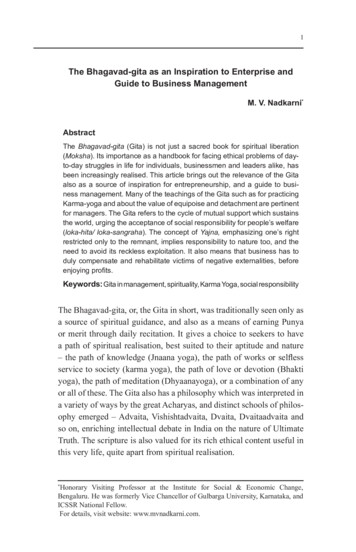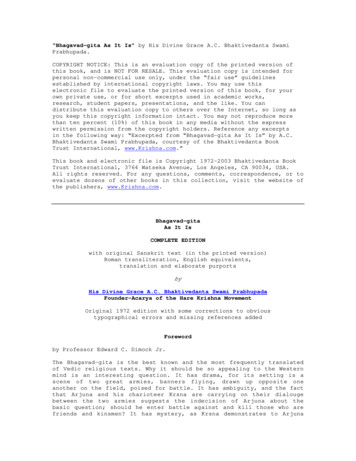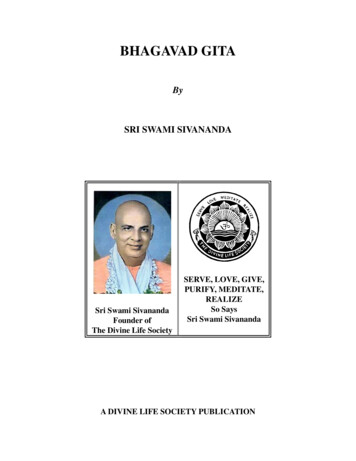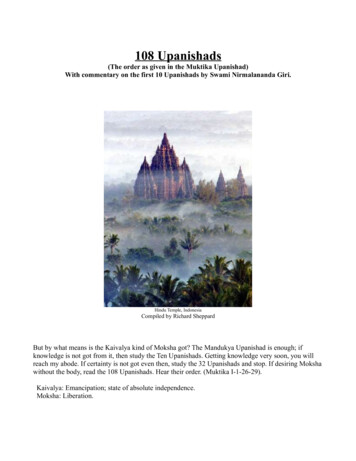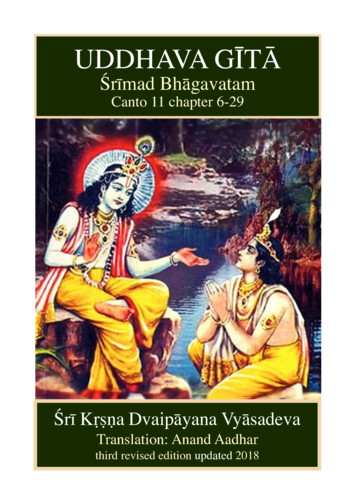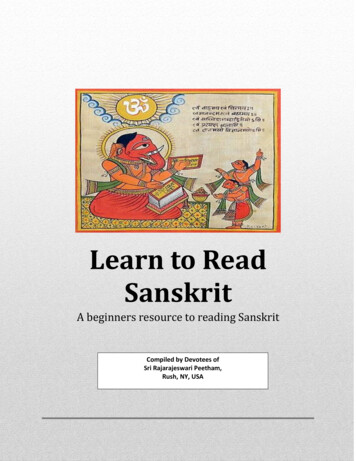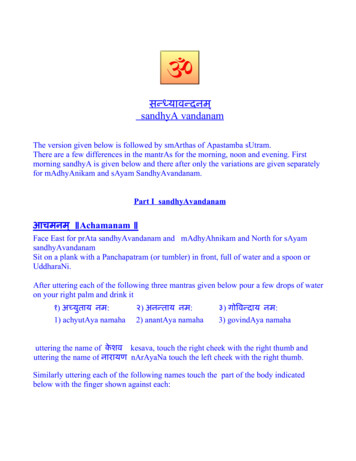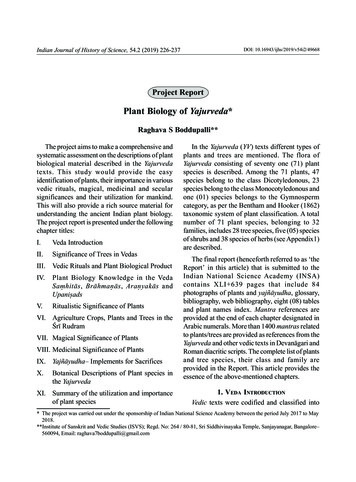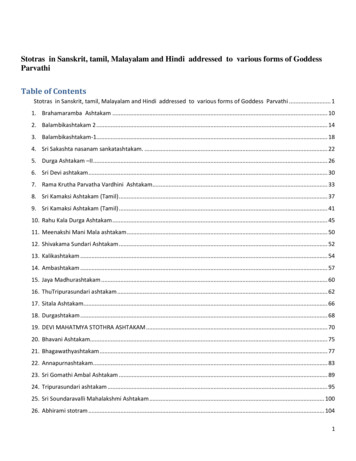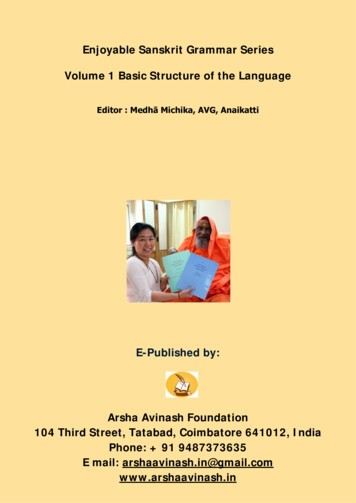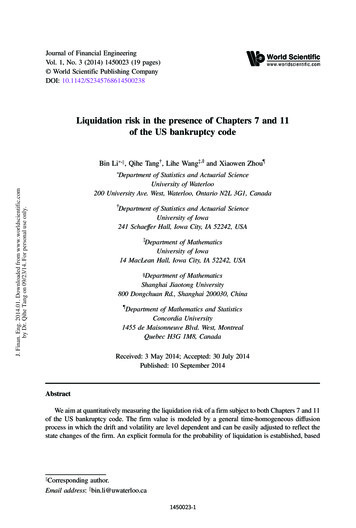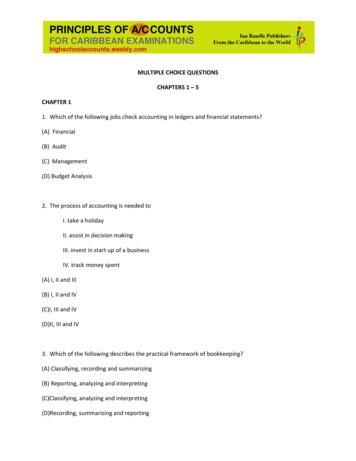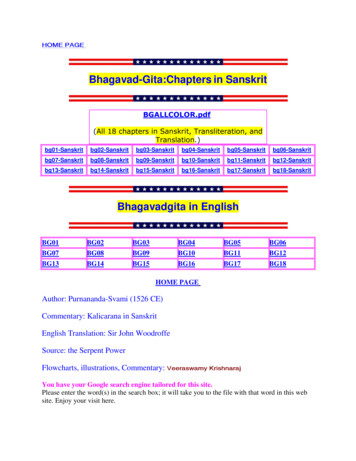
Transcription
Bhagavad-Gita:Chapters in SanskritBGALLCOLOR.pdf(All 18 chapters in Sanskrit, Transliteration, Bhagavadgita in 1BG12BG13BG14BG15BG16BG17BG18HOME PAGEAuthor: Purnananda-Svami (1526 CE)Commentary: Kalicarana in SanskritEnglish Translation: Sir John WoodroffeSource: the Serpent PowerFlowcharts, illustrations, Commentary:You have your Google search engine tailored for this site.Please enter the word(s) in the search box; it will take you to the file with that word in this website. Enjoy your visit here.
SearchSat-Chakra-NirupanaSix-Chakra InvestigationDescription of and Investigation into the Six Bodily CentersBy Tantrik Purnananda-Svami (1526 CE)Sat-Chakra Nirupana is the Premier Composition on Kundalini Chakras.The Commentary was by Kalicarana in Sanskrit.This article is about Kundalini Chakras as described by Swami Purnananda.Go to Kundalini Power for more details on Kundalini Yoga.Pūrnānanda a Brahmana of Kasyappa Gotra wrote Sat-Chakra-Nirupana (1526 CE, SAka year1448) and achieved Siddhi in VasisthAsrama, about seven miles from Gauhati, Assam, India. Hewrote many other Tantrik works. This work is part of Sri-Tattva-Cintamani.English translation by Woodroffe (Serpent Power) is full in some verses; short,condensed in some verses; and modified in other verses. Some verses haveextensive commentaries and illustrations by me. This includes my comments,additions, flowcharts, drawings, montages.Translation of some Sanskrit words and phrases follows the Monier Williams dictionary and maydiffer from that of Woodroffe. For your convenience, segments of the verses and their translationare color-coded for easier identification by sight.Preliminary verse:
Atha tantrānusāreṇa ṣaṭ chakradi kramodvatahUcyate paramānanda-nirvāha-prathamāṅkurahNow I speak of (the first step) sprouting shoot of the Yoga plant of complete realization ofthe Brahman, which is to be achieved, according to the Tantras, by means of the six Cakrasand so forth in their proper order.Ucyate ParamAnanda Says Paramananda. Atha Now. tantrAnusArena followingthe Tantras PrathamAnkurah First step. nirvAha- Complete realization Sat CakradiKramodvatah Achieved by means of the six Chakras and other things.The six Chakras are Muladhara, Svadhisthana, Manipura, Anahata, Vissuddha and Ajna. Theaccomplished Kundalini Yogi only can explain the principles of Kundalini Yoga. Neither thebest of the wise nor the most advanced in age can explain them without the mercy of the Guru. Itis full of the greatness ofśa, ṣa, Ha ( श ष हthe last three letters of the Sanskrit alphabet). ṣa,Sa, Ha point to Brahma, Vishnu, and Siva.ParamAnanda is Supreme Bliss and Nityam, Vijananam and Anandam (Eternal, Knowledge, Bliss). Otherthings refer to Nadis, Lingas, the five elements, Siva Sakti. presentation: Veeraswamy KrishnarajVerse 1
Merorbāhyapradeśe śaśi mihirasire savyadakṣe niṣaṇṇeMadhye nādi suṣuṁnātritaya-guṇamayi ta-tamavapuḥ kandamadyacchirahstāVajrākhyā meḍhradeśā cchirasi parigatā madyameऽsyā jvalantiIn the space outside the Meru, placed on the left and the right, are the two Siras, Sasi andMihira. The Nadi Susumna, whose substance is the threefold Gunas, is in the middle. She isthe form of Moon, Sun, and Fire; Her body, a string of blooming Dhatura flowers, extendsto the middle of the Kanda to the Head, and the Vajra inside Her extends, shining, from theMedhra to the Head.Commentary: Here is the mention of Nadis and Chakras, the knowledge of which is necessaryfor Kundalini Yoga. Meru is literally a mountain, the central pole of the world; likewise Meru isthe vertebral column of the human body. Siras and Sasi are the Moon and the Sun, Ida andPingala Nadis of the left and right side. Gunas refers to the qualities of the central Susumna Nadias Sattva, Rajas and Tamas. iniChakras.htmbāhyapradeśe in the space outside. śaśi-mihira-sire Moon and Sun Nadis Ida andPingala nadis. Meru Meru mountain spinal column from the Muladhara Chakra tothe neck. savyadakṣe niṣaṇṇe placed on the left and right. Madhye-nādi-suṣuṁnā the central Nadi or canal susumna Nadi. Remember these Nadis are subtle and notanatomical. Susumna Nadi extends from Muladhara to Brahma Randhara-the anteriorfontanel area. tritaya-guṇamayi whose substance is the three Gunas or modes: SattvaRajas and Tamas. There is a central Nadi which has three components, a tube within atube, three tubes in all: Citrini Nadi is Sattva; Vajra Nadi is Rajas; Susumna Nadi is
Tamas. Serpent Power: Page 150 lists Susumna Nadi, Vajrini Nadi, Citrini Nadi and thecentral Brahma Nadi or canal. candrasūryagnirūpā Moon-Sun-Fire form. Citrini Nadiis pale and of the form of Moon. Vajrini is of the form of Sun. Susumna is fiery red likeFire. kandamadyacchirahstā Kanda-MadhyAt-SirahsthA from the middle of theKanda to the head. Kanda means bulbous root, present in the Uro-genital Triangle inman, the point being two fingers above the anus and two fingers below the root of thephallus (medhra). 72K Nadis emerge from the Kanda, of which only three are the mostimportant: Ida, Pingala, and Susumna. Susumna goes to the neck, emerges from thespine, goes to the forehead, passes between the eyebrows united with Kundali, goesnear the Brahma Randhra and ends near the 12-petalled lotus. Susumna clings on tothe stalk of Sankhini as it goes up the spinal cord. Sankhini is a Nadi that starts atKanda, reaches the throat, divides into two branches, one branch going to the left earand the other goes to the crown. madyameऽsyā Vajrah inside her Inside SusumnaNadi. presentation: Veeraswamy KrishnarajVerse 2Tanmadhye citriņī sā praṇavavilāsitā yoginām yogagamyāLūtātantūpameyā sakalasarasijān merumadhyāntarasthānBhittva dedipyate tad-grathana-racanayā śuddha-bodha-svarūpāTanamadhye brahmanāḍī harakukha-kuharadādi-devāntarātmā.Inside her is Citrini, who is lustrous with the lustre of the Pranava and attainable in Yogaby Yogis. She (Citrini) is subtle as a spider's thread, and pierces all the Lotuses which areplaced within the backbone, and is pure intelligence. She (Citrini) is beautiful by reason of
these (Lotuses) which are strung on her. Inside her (Citrini) is the Brahmanadi, whichextends from the orifice of the month of Hara to the place beyond, where Adi-deva is.Tanmadhye Inside Her (Vajra). praṇavavilāsitā lustrous within the luster of Pranava(om). She absorbs the luminosity from Pranava in Ajna Chakra as she passes through it.Lūtātantūpameyā like a spider's thread. She is fine like a spider's thread. sakalasarasijānmerumadhyāntarasthān Bhittva dedipyate She pierces all the lotuses. Tanamadhye inside Her. Within Citrini is Brahma Nadi, through which Kundalini goes from Muladhara toParama Siva. Kundalini is of the from of Sabda Brahman. harakukha-kuhara The orifice ofmouth of Hara. It is the orifice at the top of the Svayambhu Linga in Muladhara. Adi Deva is theSupreme Bindu in the pericarp of the 1000-petalled lotus.Susumna Su Sumna Excellent musical hymn, happiness or joy perfectharmony. All these important Nadis are called Susumna. Essentially Susumna consists of thesubstance of the spinal cord with the three Nadis inside it, placed one tube inside the other. Thereis the central Nadi (Brahma Nadi), middle Nadi is Chitra Nadi (AKA Citrini) and the outerNadi (Vajra Nadi). Kundalini passes through the Central Brahma Nadi. Remember these aresubtle channels, canals or Nadis and not anatomical entities. Chitra Nadi Citrini The Nadiis anthropomorphized and deified.See the Diagram belowVerse 3
Vidyanmālā-vilāsā manimanasilasat-tantu-rūpa susūkṣmāśuddhajṅanaprabhodhā sakala-sukha-mayī śuddha-bodha-svabhāvāBrahma-dvāraṁ tadāsye pravilasati sudhādhāragamya-pradeśaṁGranthi-sthānaṁ tadetat vadanamiti suṣuṁnākhya-nadyā lapanti.She1 is beautiful like a chain of lightning and fine like a (lotus) fibre, and shines in theminds of sages. She is extremely subtle; the awakener of pure knowledge; the embodimentof all Bliss, whose true nature is pure Consciousness. The Brahma-dvara shines in hermouth. This place in the entrance to the region sprinkled by ambrosia, and is called theKnot, as also the mouth of Susumna. presentation: Veeraswamy KrishnarajShe1 Citrini who ascends through Brahma Nadi, the innermost tube of Susumna Nadi. Alsoknown as Chitra Nadi.lasat-tantu-rūpa Fine like a (lotus) fiber and shines (because of the presence ofKundalini). sakala-sukha-mayī Sukha is Ananda or Spiritual Bliss. She is the source ofall Bliss. Sukha (literal meaning) pleasant, gentle, agreeable. śuddha1-bodha2svabhāvā3 Whose true nature is Pure Consciousness. Literal meaning Pure1Consciousness2 by natural constitution3. Brahma-dvāraṁ Brahma's opening, gate,entrance or exit for Kundalini and Her ascent to Siva or descent from Siva. tadāsye her mouth. the mouth of Brahma Nadi. tadetat the place near the entrance.sudhā1dhāra2gamya3-pradeśaṁ4 literal meaning Pure-containing- union of[Parma-Siva and Sakti]-place The place that contains Ambrosia (Suddha) which
comes from the union of Siva and Sakti. Here the union (StrIpum-yogAt woman-manunion) is symbolic. Granthi-sthānaṁ Knot-place the place where there is a knot atthe root of all Nadis.sva-bhāvā: Kalicarana says it means one's nature. Sankara says it means Jnana whichis Paramatma or divine or spiritual Jnana. Sankara reads śuddha-bodha-svabhāvā asśuddha-bhāvā-svabhāvā. iniChakras.htmVerse 4Athādhārapadmaṁ suṣuṁnākhya-lagnaṁDhvajādho gudordhvaṁ bhavrṇaihVakarādisāntair yutaṁ veda-varṇaih.Next we come to the Adhara Lotus1. It is attached to the mouth of the Susumna, and isplaced below the genitals and above the anus. It has four petals of crimson hue. Its head
(mouth) hangs downwards. On its petals are the four letters from Va to Sa, of the shiningcolour of gold.From Verses 4 to 13, Paramanand describes the Muladhara Chakra. Adhara Lotus1 SupportLotus Muladhara Chakra Lotus at the base of the spine in the Uro-genital triangle.suṣuṁnākhya-lagnaṁ It is attached to the mouth of Susumna. Four Petals of theMuladhara Chakra are present at the junction of Kanda and Susumna. Dhvajādhogudordhvaṁ from below the root of the genitals to Susumna. catuh-śoṇa-patraṁ. four red petals. Red or crimpson. Vakarādisāntair yutaṁ veda-varṇaih. The fourletters are Va, śa (palatal), ṣ (cerebral), and Sa. Vedavarna Veda character meansfour Vedas. The letters on the petals are to be meditated upon in a clockwise fashion.Here Veda stands to mean four. The letters of the alphabet on each of the petals of thesix lotuses are to be meditated upon going round a circle from the right(Dakṣināvartena: clock-wise direction.)
Verse 5
Amuṣmin dharāyaś-catuṣkoṇa-cakraṁSamudbhāsi śūlāṣṭakairāvṛtaṁ tat.Lasat pītā-varṇaṁ tadit-komalāngaṁTadante samāste dharāyāḥ svabījaṁIn this (Lotus) is the square region (Cakra) of Prthivi, surrounded by eight shining spears.It is of a shining yellow colour and beautiful like lightening, as is also the Bija of Dharawhich is within.Parts of the translation are not by Woodroffe.Amuṣmin dharāyaś-catuṣkoṇa-cakraṁ In this (Lotus), Earth's four-angle Chakra.dharāyāḥ svabījaṁ: Bija of Dhara: it is the Root mantra of Earth, Lam. Prithvi is Earth, whichis a Tattva, principle or building block of the world. śūlāṣṭa Asta Sula 8 spears. Eightspears meaning eight directions or points of compass. Lasat pītā-varṇaṁ taditkomalāngaṁ shining yellow color, beautiful like a lightning, having a tender body.Tadante samāste dharāyāḥ svabījaṁ within it seated Bija of Dhara: it is the Root Mantraof Earth, Lam. Prithvi is Earth, which is a Tattva, principle or building block of the world. Tadante inside the region of Prithvi (Dhara Mandala), which is the Bija of Earth: Lam. ThisBija is of shining yellow color (Lasat-pIta-varnam shining yellow color). lam is AindraBIja (Bija of Indra) of yellow color possessed of four arms, holding the thunder in onehand, mighty and seated on the elephant Airavata.The Kundalini Chakras from Sahasrara to Muladhara centers are the home for the buildingblocks of the human body. Ajna Chakra is the home for the mind, Vishuddha for Ether, Anahatafor air, Manipura for fire, Svadhistana for water and Muladhara for earth. All the elements areassigned a shape and color: Earth is yellow and square; Water is translucent and crescent-shaped;Fire is red and triangular; Air is blue and circular; Ether is smoky and undalini Chakras.htm
In the pericarp of the lotus is present the square Earth. Earth is round but its representation hereis a square and of yellow color. The four angles and four side have the eight spears (see thearrows). The tips of the spears are shaped like the breast of a woman or the mountain. Rememberthe name of Wyoming's majestic mountains, 'Grand Tetons' of Grand Teton National park.Woodroffe quotes Nirvana Tantra by saying that the eight spears are like the seven KulaMountains: Nilacala, Mandara, Chandr Sekhara, Himalaya, Suvela, Malaya, and Suparvata. Thespears are those of Deity Dakkini, one of the Bhairavis (Consort of Bhava--Siva) BHAIRAVIThe Bija Mantra (Lam) is right in the middle of the square earth. It is of yellow color. It is theBija of Indra (the god of thunder and lightning of the Indo-Aryans) who holds the thunderbolt inone hand sitting on the elephant Airavata. The Bija of Earth and of Indra are the same. It is saidthat Indra has mighty arms; the tips of his
BGALLCOLOR.pdf (All 18 chapters in Sanskrit, Transliteration, and Translation.) bg01-Sanskrit bg02-Sanskrit bg03-Sanskrit bg04-Sanskrit bg05-Sanskrit bg06-Sanskrit bg07-Sanskrit bg08-Sanskrit bg09-Sanskrit bg10-Sanskrit bg11-Sanskrit bg12-Sanskrit bg13-Sanskrit bg14-Sanskrit bg15-Sanskrit bg16-Sanskrit bg17-Sanskrit bg18-Sanskrit Bhagavadgita in English BG01 BG02 BG03 BG04 BG05 BG06
